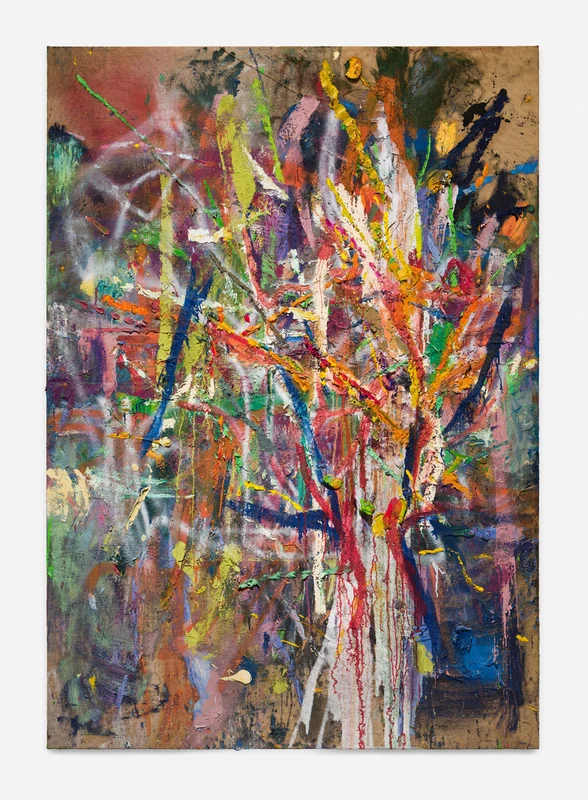Spencer Lewis: Odds and Sods
13 Oct-18 Nov 2022
PV 13 Oct 2022, 6-8pm


Josh Lilley is thrilled to announce the opening of Spencer Lewis’ debut exhibition with the gallery, and his first show in London.
Incesticide is no-one’s favourite Nirvana album. Released a year after the triumphant success of Nevermind, it’s a kind of stopgap compilation of B-sides and outtakes, a means of stemming the flow of bootleg recordings. In his essay “Oh, the Guilt”, Chuck Klosterman describes it as “guilt rock”: music made by a band that saw itself as small becoming unexpectedly, and embarrassingly, huge. Each painting in Spencer Lewis’ new body of work is named after a different track on that album, and by doing so draws a line between its noisy neuroses and his own ambivalent channelling of painting’s wildest edges. The language of Lewis’ work – muscular gestural abstraction, let’s say – comes, like Nirvana’s own music, already freighted with performance anxiety. What kind of possibilities remain for that sort of densely wrought, hard-won expressionism? Lewis’ paintings don’t answer that question. They ask it.
The jute surfaces of Lewis’ paintings provide a means for his work to stage a kind of tussle with itself. The fuzzy skin of unprimed jute does exactly what oil paint doesn’t want: it resists its own erasure, intransigently remaining visible even in his paintings’ densest parts, like the hiss and crackle of a bad recording. What the jute also calls to mind is a drop cloth laid on a studio floor, although to read this as a note of old-fashioned studio fetishism is to miss something in his work that the Nirvana nods insistently bring to the surface. Easy as it is to see his paintings as straightforwardly inhabiting the territory of mid-century abstract painting, to do so would be to miss their play with its tropes. Lewis marshals the trappings of modernist authenticity – big, splattering paint strokes; wilful disregard for finish, in both senses of the word; wild, unruly colour – not to subvert them, as artists did in the 60s, but to prod them for signs of life. And it turns out there is life there, just one perennially haunted, as Nirvana’s music was, by doubt. Lewis’ work, energised by that doubt, is a serious move in the long endgame of modernist abstraction.
Which is doubtful in itself. Consistent in Lewis’ paintings is their gestures’ honing-in on the centre of the support, like darts to a bullseye. It’s in this regard that the artist’s claim to painting in a basically figurative manner feels true. These marks are building up towards something: they are on the brink of readability, sitting just out of the reach of description. As their centres amass layers of ever-denser, ever-brighter paint, it’s like a gradual apprehension, a coming-into-focus. The stains and swirls they build upon create an internal history for each painting, with each additional colour standing for another moment in the life of the artist painting them and any viewer perceiving them. In that way, they’re like songs: they trap time and return it to us changed. And change us, too. Lewis’ works find something inside the inherited odds and sods of painting’s past, something about authenticity and selfhood, which is, as everyone knows, news that stays news.
- Ben Street, September 2022
---
Spencer Lewis (b. 1979 in Hartford, CT), received his BFA from the Rhode Island School of Design in 2001 and his MFA from the University of California, Los Angeles in 2008. Throughout his career, Lewis has worked with jute, cardboard, bronze and assemblage; often with paint and always with space. Space, how to negotiate it, imply it or fill it, is the purpose of a practice that is as much interested in the intervention a painting poses within a given environment as the painting itself. In his Los Angeles studio Lewis explores this space, pinning it to canvas, assembling dynamically painted windows into a plain of intersecting marks, arching and thrashing to form billowing compositions of rich colour. Whilst his works may range in scale, a raw physicality abounds throughout the brute lines of oil, acrylic, enamel and ink smeared, struck and scooped onto a weathered, giving surface. Whether rendered in hazy mists, neon slashes or fibrous folds, Lewis’ mark making is unbridled, his palette always expanding.